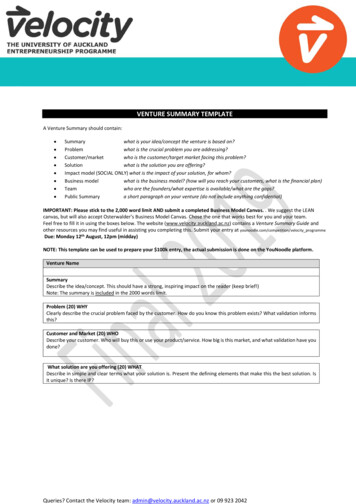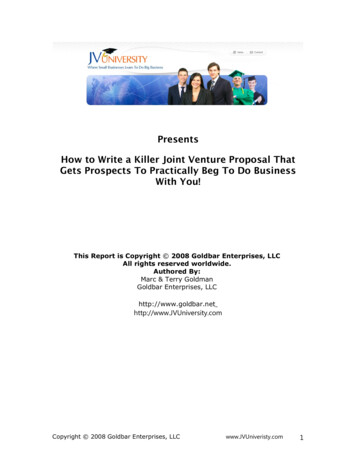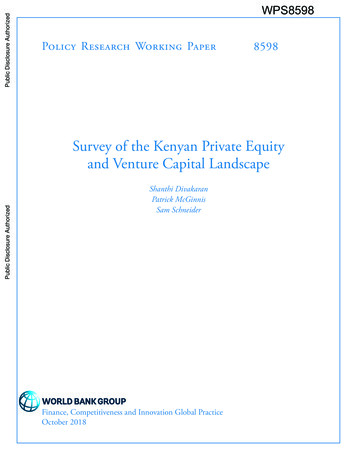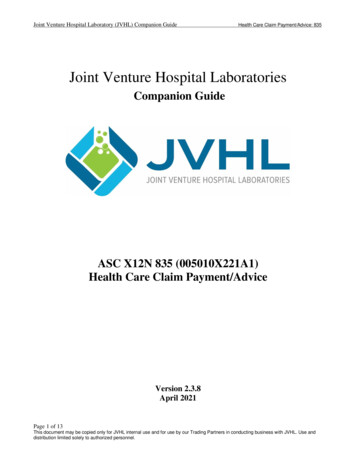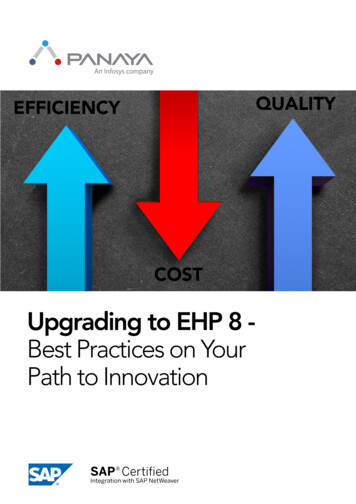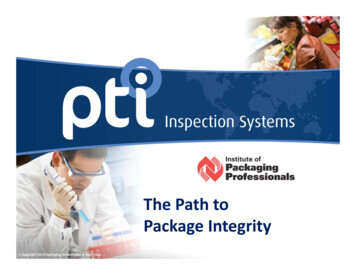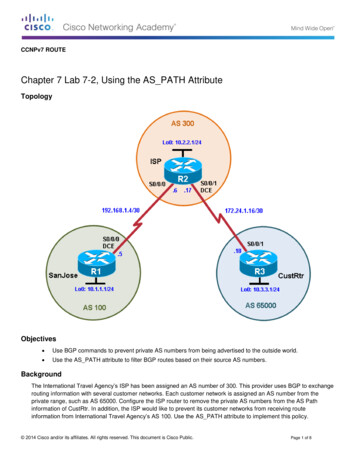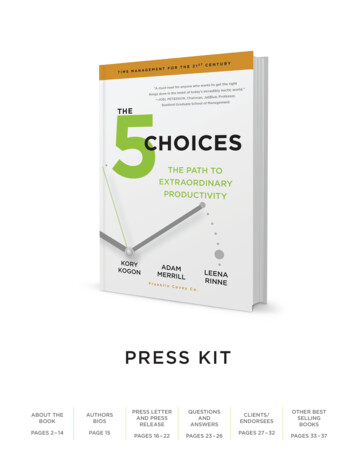
Transcription
Venture PathHelping corporates growlike startups
Venture PathVenture Path is Deloitte’s approach forenabling large enterprises to respond todisruption and innovate in a digital world.The proposition is designed to help themsustainably launch new business modelsand embed lean startup innovation intheir organisation.02
What is lean startup?Why does this matter?Lean startup is a scientific approachto innovation that focuses on testingand iterating ideas based on real-worldfeedback, throughout development.This contrasts with approaches typicallytaken by established organisations,which tend to make large-scaleinvestment decisionsWith digital disruption accelerating,large corporates increasingly need toinnovate to survive.based on detailed, yet untestedbusiness plans.BUILDMEASUREFor organisations that manage tosuccessfully adopt lean startup atscale, there are a number of powerfulbenefits, including: Radically improved speed and abilityto respond to disruption Significantly reduced risk and cost ofinnovation B etter performing products andservices, tailored to customerpreferencesLEARN03 Deloitte 2017
Venture PathWhy Venture Path?Lean startup is no longer a new concept,but our clients consistently struggle toembed disruptive innovation in theirorganisations. We developed VenturePath in order to create a comprehensiveanswer to common questions we havebeen asked by clients.“What’s the best way to test and build newbusiness models?”“What are the right structures, rolesand processes we need to innovatemore effectively?”“How can we consistently track andmeasure all of our innovation activity?”04
Venture PathWhat is included within Venture Path?Venture Path is made up of three key components. Each component is valuable toan organisation in its own right, but it is the combination of all three that creates asustainable and efficient innovation engine.Venture Path MethodVenture Path StructureVenture Path PlatformThe lean startup methodology to testand validate new ideas as quickly andinexpensively as possibleThe blueprint structures, roles andprocesses need to run and govern leaninnovation in large enterprises, from ideageneration to scalingThe software platform to track andmeasure lean innovation activity at scale05
Venture PathMethod06
Venture PathVenture Path MethodOverviewVenture Path Method includes Deloitte’s lean startup process to helpclients test and validate new ideas as quickly and cheaply as possibleThe Venture Path Method encourages organisations totake a different approach to innovation; one that embracesentrepreneurial thinking, rapid experimentation and acceptsa degree of failure. This is because the ultimate goal at thestart of any new venture should be to learn quickly, not growquickly. Companies that target revenue growth too early arealmost certain to fail.Are we creating a product orservice that genuinely createsvalue for a consumer?How will new customersdiscover and purchaseour product?What are the benefits? An ability to innovate faster and cheaper than traditionalapproaches, avoiding wasted time and resources The opportunity to de-risk investments by validatingconcepts as early as possible and throughouttheir development A repeatable, process that can be embedded in anorganisation to test and develop new ideasProductMarket fitSTARTTHE VALUE HYPOTHESISTHE GROWTH HYPOTHESIS07 Deloitte 2017
How does themethod work?Venture Path includes a three-step process totest and validate new ideas. At each step weexplore the following three questions:Venture PathAt each stage, If the answer to these questions is ‘yes’, the concept proceeds to the next step,otherwise it is iterated or ultimately killed. The burden of proof increases at each step, so that bythe end of the Venture Path process, an idea will have been rigorously tested through real-worldexperimentation and be ready for further investment to scale.01. Is there demand?(The value proposition)102. Is it worth it?23(The business model)siposipoValueb ili t ie s a n d St r uSTOPc tureP rosipoP roValueP ropao delCasMreEATSTOPc tuBunese s a n d St r uPROCEED ERs inb ili t io delpaDevelopingMINIMUM VIABLEPRODUCTS(MVPs)sMCao delFitPROCEED t ioessMEstablishingPROBLEM-SOLUTIONBuns int ioITEREATEATBunes(Capabilities and structure)t ios in03. Can we do it?ITERValueITTrading thePILOT VENTURECapab ili t ie s a n d St r uc tuPROCEED reSTOP08
TypicalapproachesTo embed the Venture Path methodologyin an organisation, there are twokey approaches:Venture PathDeep-dive projectsWe work with client teams on a specific venture idea and run the Venture Pathprocess as a joint project. The venture becomes a proof of concept to transfer leanstart-up knowledge to the organisation, before helping to scale the approach toother teams. These projects run in monthly sprints and are typically a minimumof 3 months.and/orTraining programmesWe create and run internal training programmes for innovation project managersand senior stakeholders across an organisation to teach the concepts to a wideraudience. The sessions are designed to be interactive with workshops and teamexercises to apply the methodology over the duration of the course. Dependingupon the size of the organisation, the programmes are either in a focused 1-2 weekperiod or spaced out as 1-day sessions over a number of weeks.To find out more about how the Venture Path method could be applied within your organisation,please email venturepath@deloitte.co.uk.09
Venture PathStructure10
Venture PathVenture Path StructureOverviewStructureVenture Path Structure is Deloitte’s set of blueprint structures, roles and processesneeded to run lean innovation in large enterprises, from idea generation to scaling.We have developedsome key principles fordelivering and governingnew innovation initiatives,based on our extensiveobservations regardingthe common problemsorganisations experiencein this domain:Validate Demand Many initiatives andventures die not becausethey cannot be built butbecause customers simplydo not want them enoughCompanies tend to havea view of what theircustomers want, butnothing beats asking themdirectly and measuringtheir response New products are oftendeveloped under theassumption that once theyare built, the job is done In reality, concepts rarelysurvive first contact withreal customers and it iscrucial to adapt them.Similarly, technologiesadvance and expectationschange so it is critical toevolve propositions overtime to remain competitiveStructure foraccountabilitySet actionablemetricsIterate & improve When corporates investin an idea, they rarely setmeasurable goals or trackprogress in a meaningfulway. The metrics usedto measure establishedbusiness units simply donot work for new, as yetunvalidated venturesWithout access to dataon the key metrics of theventure, it is impossible tomake informed businessdecisions Large enterprisescan sometimes treatinnovation as an ‘edgeof desk’ activity; costoptimisation is ingrainedin our business culture butcan be fatal to getting newideas off the ground New ventures requirededicated resources withautonomy and control,unhindered by corporatebureaucracyInnovation isa profession The capabilities andculture befitting rapidinnovation are not typicalof those seen in companiesdelivering scaled,established businessmodels Whether through hiring,upskilling and coachingexisting teams ordeveloping partnerships,businesses must find waysof developing innovationcapabilities11
Venture PathDeloitte’s Venture Path Structure includes a framework for how to manage innovations from the inception of an idea through to scaling it into a fully-fledged businessmodel (or not) within the context of large businesses that lack the lean management systems of smaller scale start-upsONGOING1. IDEATIONCommunicationsand cultureCOACHINGIdea generationStructure2. PRIORITISATIONIdea collationFilterSelection& fundingConcept discoveryENDORSEMENTCOMMUNICATIONSQuestions addressed by VenturePath Structure: Where will innovation be owned– within the core business or ina separate team? What internal and externalcommunicationsare needed? How can Leadershipbest endorse and incentiviseinnovation? Do we need to coach thebusiness in more innovativeways of working and thinking? How will we generate new ideas?Do need to run innovationsessions? How often? Withwhom? How can we crowdsource ideas? How will we ‘scan the horizon’ totrack the latest trends and workthis insight into our plans? How can we identify customerand partner ‘pain points’ orrequests? Who owns and co-ordinatesthe innovation portfolio? What buy-in is required toensure strategic alignment? How can we ensure it iscategorized and aligned toour strategy and is balancedacross Core, Adjacent andNew products, markets andchannels? According to which criteriawill we filter innovationinitiatives? Who will share and enrichideas so that they have:–– Target personas andsegments?–– A proposition valuehypothesis?–– Supporting userjourneys or wireframes?Do we need to allocate‘venture builders’ for this?Is it a full-time role? Who selects and funds ideasfor further development? What does a ‘pitch‘ forfunding need to look like? How will we consistentlyprioritise what to pursuefirst?DROPGO
Our work with clients in this domain involves helping them to implement he specific structures, roles and processes that best enable their organisation to deliver andgovern lean startup innovation in this mould.3. INCUBATION AND VALIDATIONRapid prototypingand testinge s a n d St r usipoCarepaSTOP How much (budgetary)discretion do venturebuilders have? What processes need to befollowed (if any) to gather insightand feedback from customersand the rest of the business? c tuPropoProValuesipoProValuesibilitiTrading thePILOTVENTUREbilitie s a n d St r uc tuo delpasMSTOPCaesrePROCEED RBuonScaling into the existingmanagement systemProduct developments inc tuInvestment caseand go-to-marketEATe s a n d St r uo delbilitio OCEED esesEstablishingPROBLEMSOLUTIONFittis ins intiBuonITEREATEATtiITERStructure4. SCALE AND GROWReview and decisionValueITEBuonVenture PathPROCEED reSTOP How often should we meet toreview progress? What return do we require, overwhat period? How will we determine whoowns the product or service? What needs to be agreed at thestart of each sprint or iteration? How will we determine whetherto: Should we incorporate theroadmap into our broadertechnology landscape?How? When?––––Should we have ‘ring-fenced’teams to deliver MVPs and Pilots––Deliver the new product orservice internally?Partner with anotherorganisation?Acquire the capabilitieswe need via anotherbusiness? Do we have the capabilitiesand tools we need tomanage and grow new digitalbusiness models? What metrics and performancereporting cycles should we havein place for our establishedbusinesses?13DROPSCALE
TypicalapproachesVenture PathStructureHow, where and to what degree each business can best employ the activities and tools required for lean innovation varies accordingto the existing strategy, culture and structure. We employ the the Venture Path Structure framework as part of a collaborative,iterative approach to helping our clients make important choices across a number of key areas, including:ProcessesGovernance and fundingPeople and cultureOrganisation structureData and informationTools and technologiesThe activities, decisionpoints and investmentcycles required tosystematically generate,prioritize, deliver and scalenew initiativesThe investment pots,decision criteria andforums required toeffectively ensure a returnon the business’ innovationinvestment and alignmentto strategyThe roles, skills andbehaviours required foreffective lean startupinnovation in differentsectors and domainsHow these activitiesand capabilities cometogether across structuresand reporting lines toyield success in complexbusinesses with multipledivisions and/or prioritiesThe minimal KPIs andreports needed toeffectively administer andmake informed decisionsregarding a rollinginnovation portfolioThe templates, frameworksand platforms via whichinnovation will be executedand managed14
We apply our own lean startup ethos when shaping the structure and processesbest suited to each of our clients:Phase 1 - CONSTRUCT & REFINEModel HypothesisStress test Workshops withproven frameworksand templatesRefinment with leystakeholders StructurePhase 2 - EMBED & OPTIMISEImplement & MeasureI T E R AT E Venture PathWhat are the benefits?Scenario workshopswith broader leadersand stakeholders Organisational KPIs set Fast identification of key starting points for change Personnel coachedthrough delivery of aventure through the model Early, tangible outcomes that demonstrate the valueof innovation Action plan to embed andcommunicate Continuous improvement of the model, through KPIsaligned to the organisation’s goalsTo find out more about how Venture Path Structure could beapplied within your organisation, please emailventurepath@deloitte.co.uk.15
Venture PathPlatform16
Venture Path PlatformOverviewVenture PathPlatformVenture Path Platform is Deloitte’s software platform that helps clientsexecute, track and measure lean innovation activity at scaleOur platform delivers benefit to two primary stakeholder groups: venture builders and senior managementBenefits for venture buildersBenefits for portfolio managers & senior management Step-by-step guidance through the optimal process to testand validate new business ideas Ability to scale the venture portfolio using a consistent, bestpractice approach to evaluate ideas Ability to track and manage uncertainties as they evolve,with recommendations into what to test next Visibility into the metrics that matter across the entireventure portfolio Access to best-practice tips and tricks at each stage ofthe process Opportunity to save time and money on wasted efforts byquickly pivoting or validating business ideasGood venture bu
The lean startup methodology to test and validate new ideas as quickly and inexpensively as possible Venture Path Structure The blueprint structures, roles and processes need to run and govern lean innovation in large enterprises, from idea generation to scaling Venture Path Platform The software platform to track and measure lean innovation activity at scale Venture Path 05. Method Venture .
